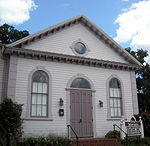District of Columbia's at-large congressional district

The District of Columbia's at-large congressional district is a congressional district based entirely of the District of Columbia. According to the U.S. Constitution, only states may be represented in the Congress of the United States. The District of Columbia is not a U.S. state and therefore has no voting representation. Instead, constituents in the district elect a non-voting delegate to the U.S. House of Representatives. Despite lacking full voting privileges on the floor of the House of Representatives, delegates are voting members in U.S. Congressional committees and they lobby their congressional colleagues regarding the District's interests. While the office was initially created during the Reconstruction Era by the Radical Republicans, Norton P. Chipman (R) briefly held the seat for less than two terms before the office was eliminated completely. The District of Columbia Delegate Act Pub.L. 91–405, 84 Stat. 845-2 of 1970 authorized voters in the District of Columbia to elect one non-voting delegate to represent them in the United States House of Representatives. The act was approved by Congress on September 22, 1970 and subsequently signed into law by President Richard Nixon. Democrat Walter E. Fauntroy was elected as the district's delegate to Congress in a special election on March 23, 1971, receiving 58 percent of the 116,635 votes cast.Since 1993, when the House of Representatives has been under Democratic control, delegates, including the District of Columbia's delegate, have been allowed to cast non-binding floor votes when the House of Representatives was operating in the Committee of the Whole.The district is currently represented by Democrat Eleanor Holmes Norton.
Excerpt from the Wikipedia article District of Columbia's at-large congressional district (License: CC BY-SA 3.0, Authors, Images).District of Columbia's at-large congressional district
L Street Northwest, Washington
Geographical coordinates (GPS) Address Phone number Website Nearby Places Show on map
Geographical coordinates (GPS)
| Latitude | Longitude |
|---|---|
| N 38.904166666667 ° | E -77.017222222222 ° |
Address
Meridian at Mount Vernon Triangle
L Street Northwest 425
20001 Washington
District of Columbia, United States
Open on Google Maps








